ITECH7409 Software Testing: Comparative Analysis of Software Standards
VerifiedAdded on 2023/06/09
|10
|2757
|114
Report
AI Summary
This report provides an in-depth analysis of software testing standards, comparing the Australian national standard (NATA) with the international standard (ISO/IEC/IEEE 29119). It examines the copyright holders, contributors, scope, and key terms of each standard. The report discusses the application and relevance of these standards to software testing, highlighting their similarities and significant differences. Furthermore, it explores test management tools, specifically TestRail and Zephyr, comparing their features and functionalities in the context of software test management. The conclusion emphasizes the importance of adhering to standards for ensuring software quality, global recognition, and a competitive advantage in the market. Desklib offers access to this and many other solved assignments and past papers for students.
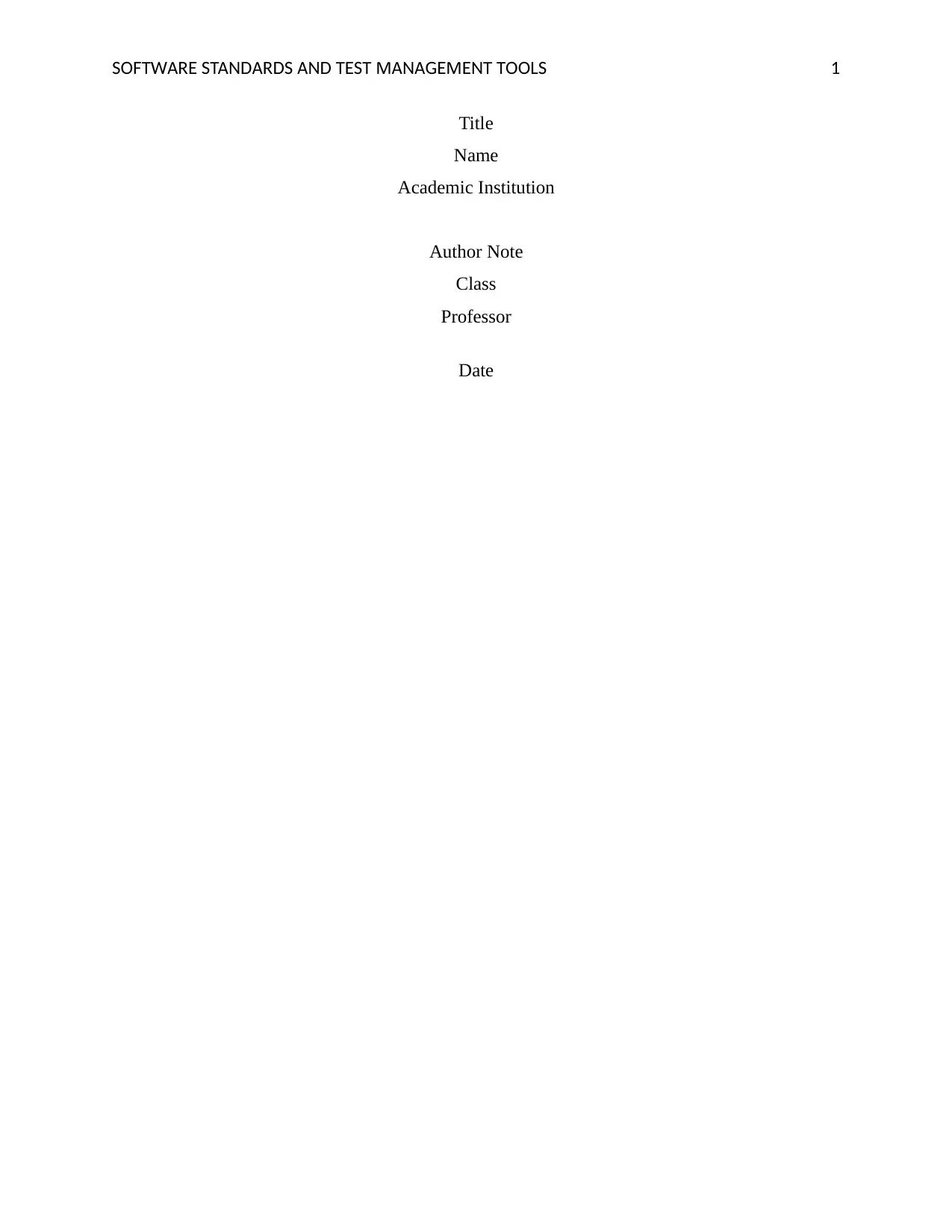
T A TA A A T T MA A M T TSOF W RE S ND RDS ND ES N GE EN OOLS 1
Title
Name
Academic Institution
Author Note
Class
Professor
Date
Title
Name
Academic Institution
Author Note
Class
Professor
Date
Paraphrase This Document
Need a fresh take? Get an instant paraphrase of this document with our AI Paraphraser
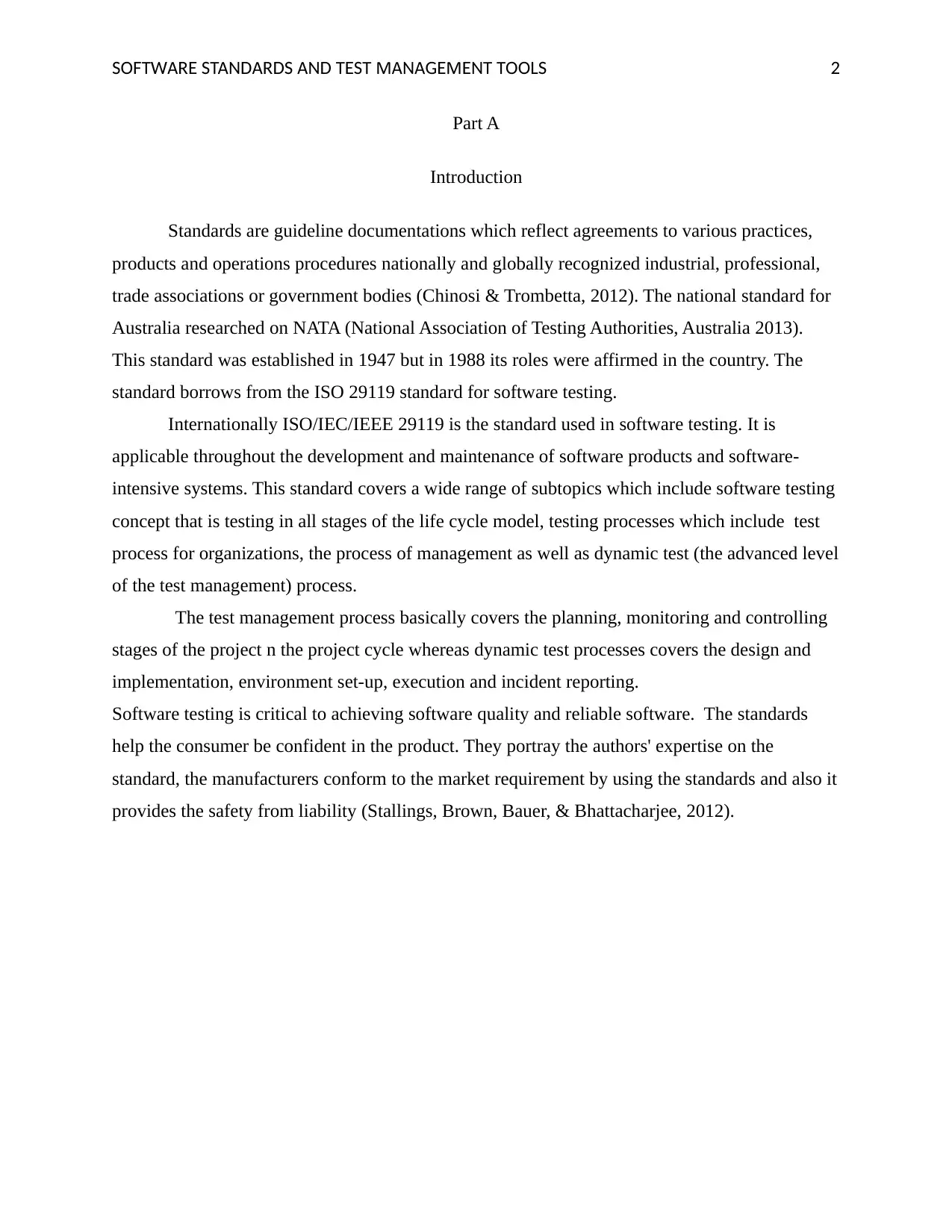
T A TA A A T T MA A M T TSOF W RE S ND RDS ND ES N GE EN OOLS 2
Part A
Introduction
Standards are guideline documentations which reflect agreements to various practices,
products and operations procedures nationally and globally recognized industrial, professional,
trade associations or government bodies (Chinosi & Trombetta, 2012). The national standard for
Australia researched on NATA (National Association of Testing Authorities, Australia 2013).
This standard was established in 1947 but in 1988 its roles were affirmed in the country. The
standard borrows from the ISO 29119 standard for software testing.
Internationally ISO/IEC/IEEE 29119 is the standard used in software testing. It is
applicable throughout the development and maintenance of software products and software-
intensive systems. This standard covers a wide range of subtopics which include software testing
concept that is testing in all stages of the life cycle model, testing processes which include test
process for organizations, the process of management as well as dynamic test (the advanced level
of the test management) process.
The test management process basically covers the planning, monitoring and controlling
stages of the project n the project cycle whereas dynamic test processes covers the design and
implementation, environment set-up, execution and incident reporting.
Software testing is critical to achieving software quality and reliable software. The standards
help the consumer be confident in the product. They portray the authors' expertise on the
standard, the manufacturers conform to the market requirement by using the standards and also it
provides the safety from liability (Stallings, Brown, Bauer, & Bhattacharjee, 2012).
Part A
Introduction
Standards are guideline documentations which reflect agreements to various practices,
products and operations procedures nationally and globally recognized industrial, professional,
trade associations or government bodies (Chinosi & Trombetta, 2012). The national standard for
Australia researched on NATA (National Association of Testing Authorities, Australia 2013).
This standard was established in 1947 but in 1988 its roles were affirmed in the country. The
standard borrows from the ISO 29119 standard for software testing.
Internationally ISO/IEC/IEEE 29119 is the standard used in software testing. It is
applicable throughout the development and maintenance of software products and software-
intensive systems. This standard covers a wide range of subtopics which include software testing
concept that is testing in all stages of the life cycle model, testing processes which include test
process for organizations, the process of management as well as dynamic test (the advanced level
of the test management) process.
The test management process basically covers the planning, monitoring and controlling
stages of the project n the project cycle whereas dynamic test processes covers the design and
implementation, environment set-up, execution and incident reporting.
Software testing is critical to achieving software quality and reliable software. The standards
help the consumer be confident in the product. They portray the authors' expertise on the
standard, the manufacturers conform to the market requirement by using the standards and also it
provides the safety from liability (Stallings, Brown, Bauer, & Bhattacharjee, 2012).
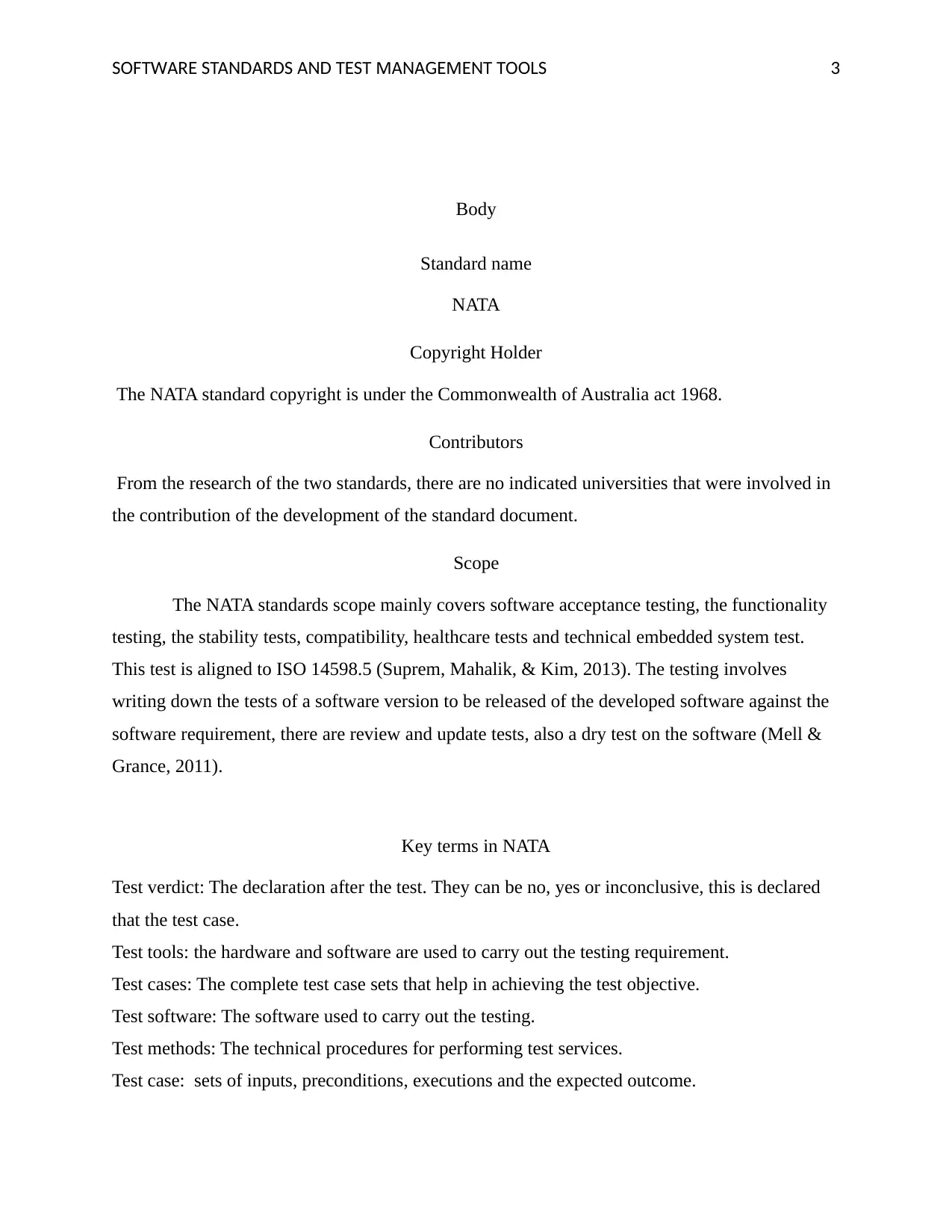
T A TA A A T T MA A M T TSOF W RE S ND RDS ND ES N GE EN OOLS 3
Body
Standard name
NATA
Copyright Holder
The NATA standard copyright is under the Commonwealth of Australia act 1968.
Contributors
From the research of the two standards, there are no indicated universities that were involved in
the contribution of the development of the standard document.
Scope
The NATA standards scope mainly covers software acceptance testing, the functionality
testing, the stability tests, compatibility, healthcare tests and technical embedded system test.
This test is aligned to ISO 14598.5 (Suprem, Mahalik, & Kim, 2013). The testing involves
writing down the tests of a software version to be released of the developed software against the
software requirement, there are review and update tests, also a dry test on the software (Mell &
Grance, 2011).
Key terms in NATA
Test verdict: The declaration after the test. They can be no, yes or inconclusive, this is declared
that the test case.
Test tools: the hardware and software are used to carry out the testing requirement.
Test cases: The complete test case sets that help in achieving the test objective.
Test software: The software used to carry out the testing.
Test methods: The technical procedures for performing test services.
Test case: sets of inputs, preconditions, executions and the expected outcome.
Body
Standard name
NATA
Copyright Holder
The NATA standard copyright is under the Commonwealth of Australia act 1968.
Contributors
From the research of the two standards, there are no indicated universities that were involved in
the contribution of the development of the standard document.
Scope
The NATA standards scope mainly covers software acceptance testing, the functionality
testing, the stability tests, compatibility, healthcare tests and technical embedded system test.
This test is aligned to ISO 14598.5 (Suprem, Mahalik, & Kim, 2013). The testing involves
writing down the tests of a software version to be released of the developed software against the
software requirement, there are review and update tests, also a dry test on the software (Mell &
Grance, 2011).
Key terms in NATA
Test verdict: The declaration after the test. They can be no, yes or inconclusive, this is declared
that the test case.
Test tools: the hardware and software are used to carry out the testing requirement.
Test cases: The complete test case sets that help in achieving the test objective.
Test software: The software used to carry out the testing.
Test methods: The technical procedures for performing test services.
Test case: sets of inputs, preconditions, executions and the expected outcome.
⊘ This is a preview!⊘
Do you want full access?
Subscribe today to unlock all pages.

Trusted by 1+ million students worldwide
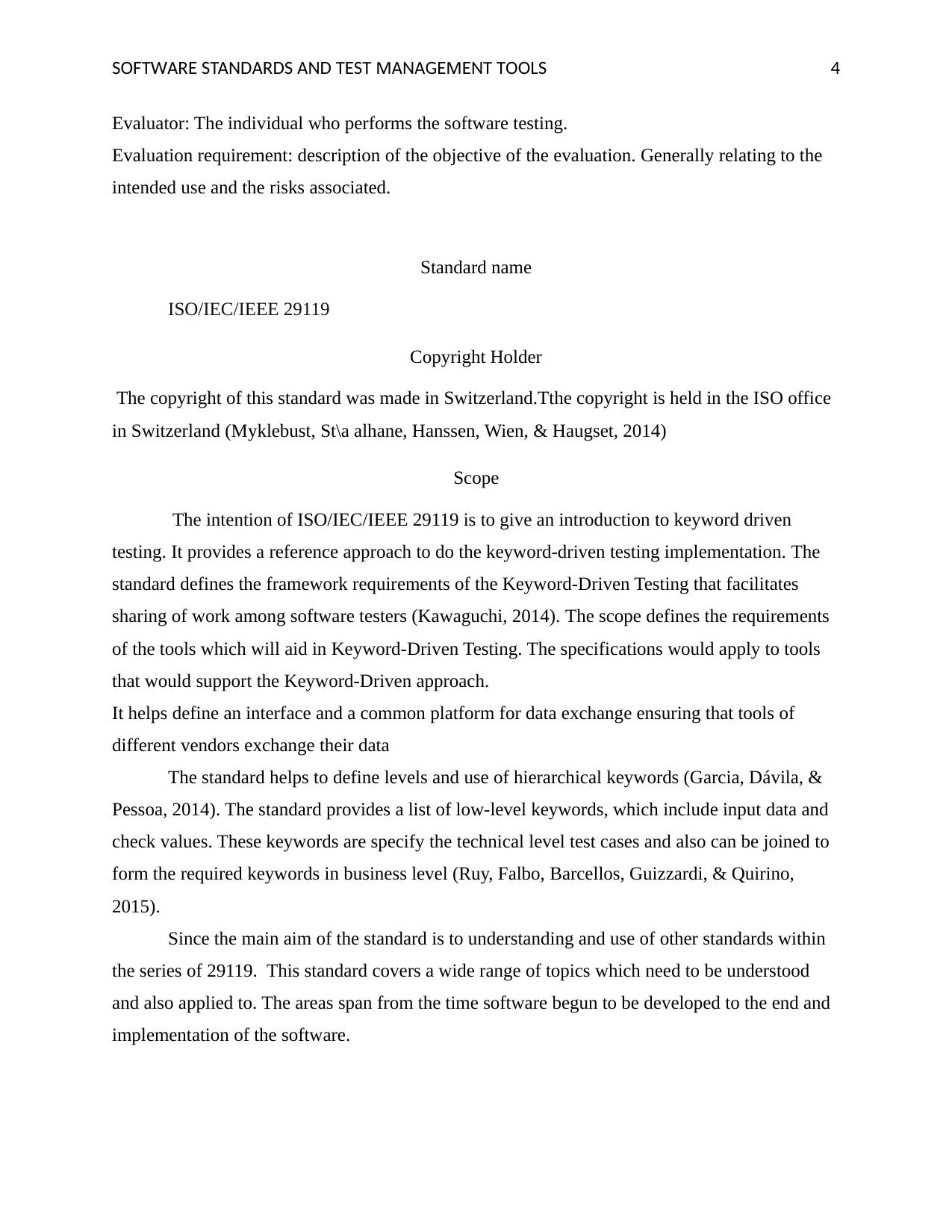
T A TA A A T T MA A M T TSOF W RE S ND RDS ND ES N GE EN OOLS 4
Evaluator: The individual who performs the software testing.
Evaluation requirement: description of the objective of the evaluation. Generally relating to the
intended use and the risks associated.
Standard name
ISO/IEC/IEEE 29119
Copyright Holder
The copyright of this standard was made in Switzerland.Tthe copyright is held in the ISO office
in Switzerland (Myklebust, St\a alhane, Hanssen, Wien, & Haugset, 2014)
Scope
The intention of ISO/IEC/IEEE 29119 is to give an introduction to keyword driven
testing. It provides a reference approach to do the keyword-driven testing implementation. The
standard defines the framework requirements of the Keyword-Driven Testing that facilitates
sharing of work among software testers (Kawaguchi, 2014). The scope defines the requirements
of the tools which will aid in Keyword-Driven Testing. The specifications would apply to tools
that would support the Keyword-Driven approach.
It helps define an interface and a common platform for data exchange ensuring that tools of
different vendors exchange their data
The standard helps to define levels and use of hierarchical keywords (Garcia, Dávila, &
Pessoa, 2014). The standard provides a list of low-level keywords, which include input data and
check values. These keywords are specify the technical level test cases and also can be joined to
form the required keywords in business level (Ruy, Falbo, Barcellos, Guizzardi, & Quirino,
2015).
Since the main aim of the standard is to understanding and use of other standards within
the series of 29119. This standard covers a wide range of topics which need to be understood
and also applied to. The areas span from the time software begun to be developed to the end and
implementation of the software.
Evaluator: The individual who performs the software testing.
Evaluation requirement: description of the objective of the evaluation. Generally relating to the
intended use and the risks associated.
Standard name
ISO/IEC/IEEE 29119
Copyright Holder
The copyright of this standard was made in Switzerland.Tthe copyright is held in the ISO office
in Switzerland (Myklebust, St\a alhane, Hanssen, Wien, & Haugset, 2014)
Scope
The intention of ISO/IEC/IEEE 29119 is to give an introduction to keyword driven
testing. It provides a reference approach to do the keyword-driven testing implementation. The
standard defines the framework requirements of the Keyword-Driven Testing that facilitates
sharing of work among software testers (Kawaguchi, 2014). The scope defines the requirements
of the tools which will aid in Keyword-Driven Testing. The specifications would apply to tools
that would support the Keyword-Driven approach.
It helps define an interface and a common platform for data exchange ensuring that tools of
different vendors exchange their data
The standard helps to define levels and use of hierarchical keywords (Garcia, Dávila, &
Pessoa, 2014). The standard provides a list of low-level keywords, which include input data and
check values. These keywords are specify the technical level test cases and also can be joined to
form the required keywords in business level (Ruy, Falbo, Barcellos, Guizzardi, & Quirino,
2015).
Since the main aim of the standard is to understanding and use of other standards within
the series of 29119. This standard covers a wide range of topics which need to be understood
and also applied to. The areas span from the time software begun to be developed to the end and
implementation of the software.
Paraphrase This Document
Need a fresh take? Get an instant paraphrase of this document with our AI Paraphraser
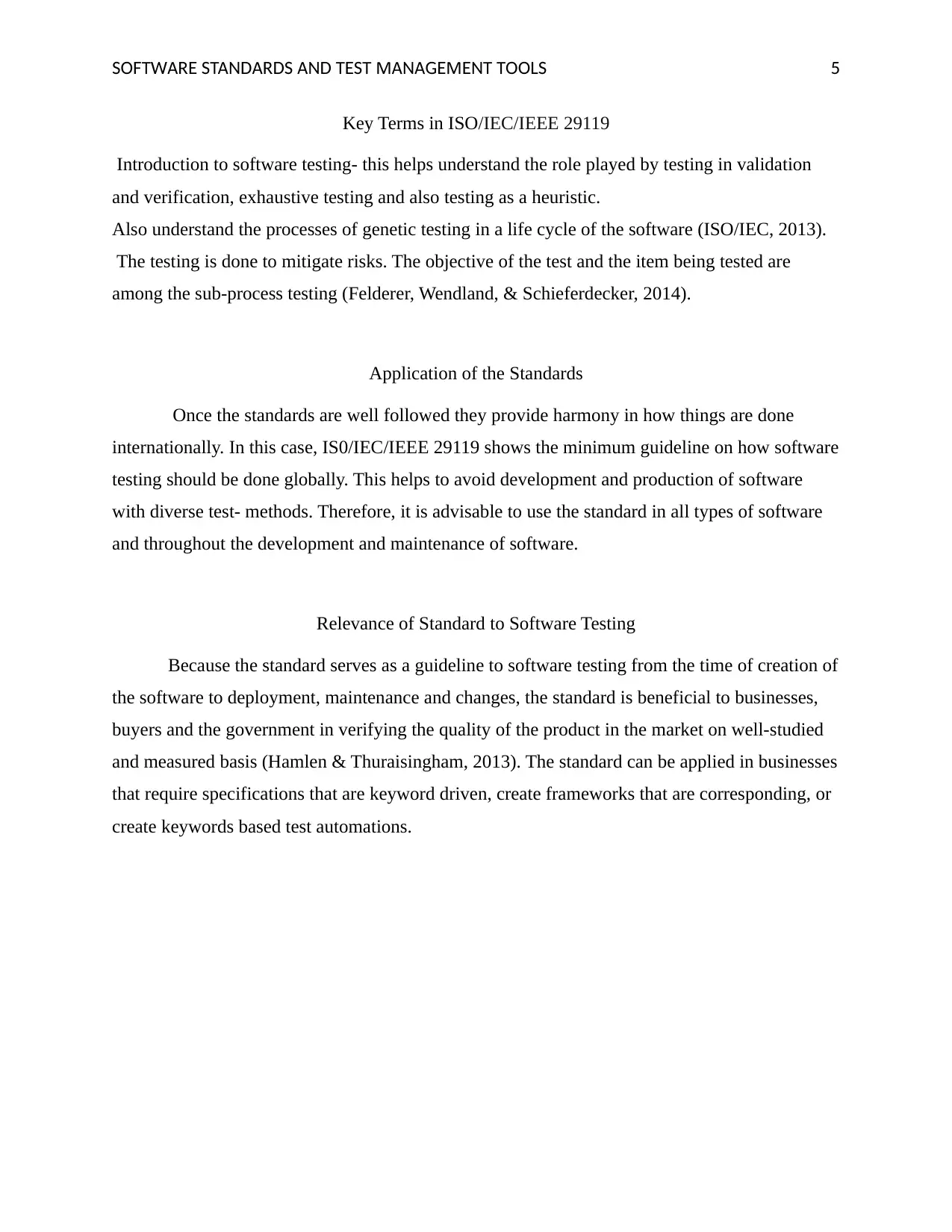
T A TA A A T T MA A M T TSOF W RE S ND RDS ND ES N GE EN OOLS 5
Key Terms in ISO/IEC/IEEE 29119
Introduction to software testing- this helps understand the role played by testing in validation
and verification, exhaustive testing and also testing as a heuristic.
Also understand the processes of genetic testing in a life cycle of the software (ISO/IEC, 2013).
The testing is done to mitigate risks. The objective of the test and the item being tested are
among the sub-process testing (Felderer, Wendland, & Schieferdecker, 2014).
Application of the Standards
Once the standards are well followed they provide harmony in how things are done
internationally. In this case, IS0/IEC/IEEE 29119 shows the minimum guideline on how software
testing should be done globally. This helps to avoid development and production of software
with diverse test- methods. Therefore, it is advisable to use the standard in all types of software
and throughout the development and maintenance of software.
Relevance of Standard to Software Testing
Because the standard serves as a guideline to software testing from the time of creation of
the software to deployment, maintenance and changes, the standard is beneficial to businesses,
buyers and the government in verifying the quality of the product in the market on well-studied
and measured basis (Hamlen & Thuraisingham, 2013). The standard can be applied in businesses
that require specifications that are keyword driven, create frameworks that are corresponding, or
create keywords based test automations.
Key Terms in ISO/IEC/IEEE 29119
Introduction to software testing- this helps understand the role played by testing in validation
and verification, exhaustive testing and also testing as a heuristic.
Also understand the processes of genetic testing in a life cycle of the software (ISO/IEC, 2013).
The testing is done to mitigate risks. The objective of the test and the item being tested are
among the sub-process testing (Felderer, Wendland, & Schieferdecker, 2014).
Application of the Standards
Once the standards are well followed they provide harmony in how things are done
internationally. In this case, IS0/IEC/IEEE 29119 shows the minimum guideline on how software
testing should be done globally. This helps to avoid development and production of software
with diverse test- methods. Therefore, it is advisable to use the standard in all types of software
and throughout the development and maintenance of software.
Relevance of Standard to Software Testing
Because the standard serves as a guideline to software testing from the time of creation of
the software to deployment, maintenance and changes, the standard is beneficial to businesses,
buyers and the government in verifying the quality of the product in the market on well-studied
and measured basis (Hamlen & Thuraisingham, 2013). The standard can be applied in businesses
that require specifications that are keyword driven, create frameworks that are corresponding, or
create keywords based test automations.
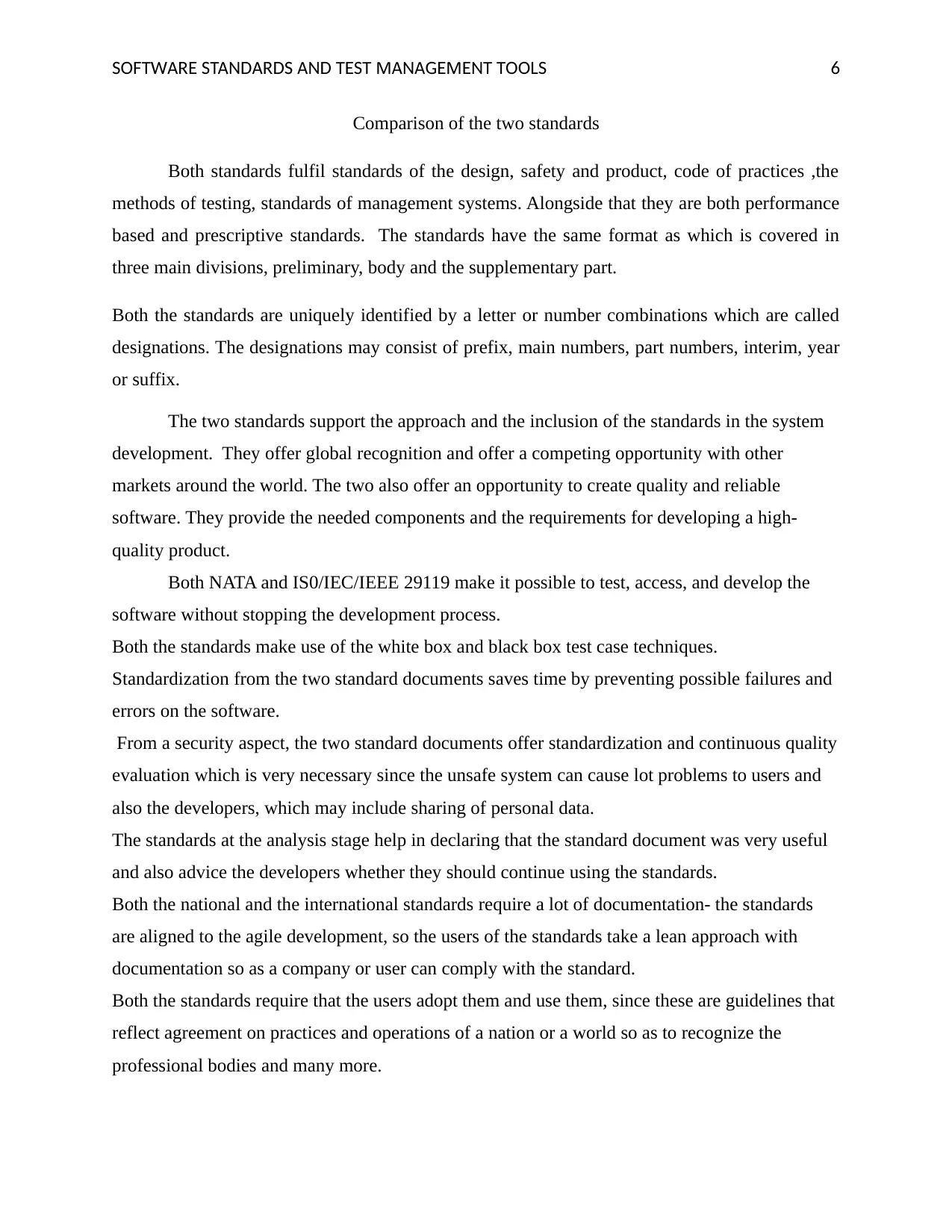
T A TA A A T T MA A M T TSOF W RE S ND RDS ND ES N GE EN OOLS 6
Comparison of the two standards
Both standards fulfil standards of the design, safety and product, code of practices ,the
methods of testing, standards of management systems. Alongside that they are both performance
based and prescriptive standards. The standards have the same format as which is covered in
three main divisions, preliminary, body and the supplementary part.
Both the standards are uniquely identified by a letter or number combinations which are called
designations. The designations may consist of prefix, main numbers, part numbers, interim, year
or suffix.
The two standards support the approach and the inclusion of the standards in the system
development. They offer global recognition and offer a competing opportunity with other
markets around the world. The two also offer an opportunity to create quality and reliable
software. They provide the needed components and the requirements for developing a high-
quality product.
Both NATA and IS0/IEC/IEEE 29119 make it possible to test, access, and develop the
software without stopping the development process.
Both the standards make use of the white box and black box test case techniques.
Standardization from the two standard documents saves time by preventing possible failures and
errors on the software.
From a security aspect, the two standard documents offer standardization and continuous quality
evaluation which is very necessary since the unsafe system can cause lot problems to users and
also the developers, which may include sharing of personal data.
The standards at the analysis stage help in declaring that the standard document was very useful
and also advice the developers whether they should continue using the standards.
Both the national and the international standards require a lot of documentation- the standards
are aligned to the agile development, so the users of the standards take a lean approach with
documentation so as a company or user can comply with the standard.
Both the standards require that the users adopt them and use them, since these are guidelines that
reflect agreement on practices and operations of a nation or a world so as to recognize the
professional bodies and many more.
Comparison of the two standards
Both standards fulfil standards of the design, safety and product, code of practices ,the
methods of testing, standards of management systems. Alongside that they are both performance
based and prescriptive standards. The standards have the same format as which is covered in
three main divisions, preliminary, body and the supplementary part.
Both the standards are uniquely identified by a letter or number combinations which are called
designations. The designations may consist of prefix, main numbers, part numbers, interim, year
or suffix.
The two standards support the approach and the inclusion of the standards in the system
development. They offer global recognition and offer a competing opportunity with other
markets around the world. The two also offer an opportunity to create quality and reliable
software. They provide the needed components and the requirements for developing a high-
quality product.
Both NATA and IS0/IEC/IEEE 29119 make it possible to test, access, and develop the
software without stopping the development process.
Both the standards make use of the white box and black box test case techniques.
Standardization from the two standard documents saves time by preventing possible failures and
errors on the software.
From a security aspect, the two standard documents offer standardization and continuous quality
evaluation which is very necessary since the unsafe system can cause lot problems to users and
also the developers, which may include sharing of personal data.
The standards at the analysis stage help in declaring that the standard document was very useful
and also advice the developers whether they should continue using the standards.
Both the national and the international standards require a lot of documentation- the standards
are aligned to the agile development, so the users of the standards take a lean approach with
documentation so as a company or user can comply with the standard.
Both the standards require that the users adopt them and use them, since these are guidelines that
reflect agreement on practices and operations of a nation or a world so as to recognize the
professional bodies and many more.
⊘ This is a preview!⊘
Do you want full access?
Subscribe today to unlock all pages.

Trusted by 1+ million students worldwide
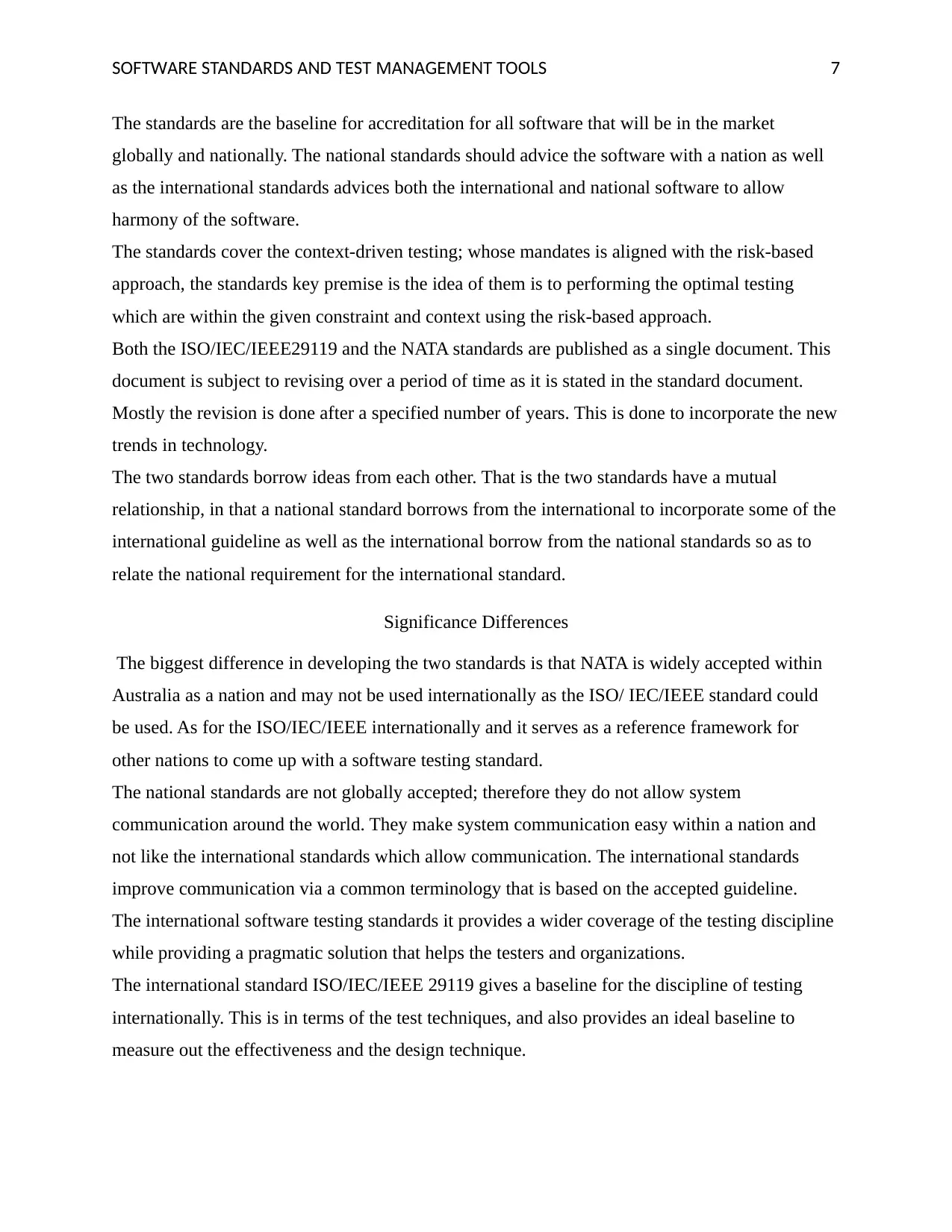
T A TA A A T T MA A M T TSOF W RE S ND RDS ND ES N GE EN OOLS 7
The standards are the baseline for accreditation for all software that will be in the market
globally and nationally. The national standards should advice the software with a nation as well
as the international standards advices both the international and national software to allow
harmony of the software.
The standards cover the context-driven testing; whose mandates is aligned with the risk-based
approach, the standards key premise is the idea of them is to performing the optimal testing
which are within the given constraint and context using the risk-based approach.
Both the ISO/IEC/IEEE29119 and the NATA standards are published as a single document. This
document is subject to revising over a period of time as it is stated in the standard document.
Mostly the revision is done after a specified number of years. This is done to incorporate the new
trends in technology.
The two standards borrow ideas from each other. That is the two standards have a mutual
relationship, in that a national standard borrows from the international to incorporate some of the
international guideline as well as the international borrow from the national standards so as to
relate the national requirement for the international standard.
Significance Differences
The biggest difference in developing the two standards is that NATA is widely accepted within
Australia as a nation and may not be used internationally as the ISO/ IEC/IEEE standard could
be used. As for the ISO/IEC/IEEE internationally and it serves as a reference framework for
other nations to come up with a software testing standard.
The national standards are not globally accepted; therefore they do not allow system
communication around the world. They make system communication easy within a nation and
not like the international standards which allow communication. The international standards
improve communication via a common terminology that is based on the accepted guideline.
The international software testing standards it provides a wider coverage of the testing discipline
while providing a pragmatic solution that helps the testers and organizations.
The international standard ISO/IEC/IEEE 29119 gives a baseline for the discipline of testing
internationally. This is in terms of the test techniques, and also provides an ideal baseline to
measure out the effectiveness and the design technique.
The standards are the baseline for accreditation for all software that will be in the market
globally and nationally. The national standards should advice the software with a nation as well
as the international standards advices both the international and national software to allow
harmony of the software.
The standards cover the context-driven testing; whose mandates is aligned with the risk-based
approach, the standards key premise is the idea of them is to performing the optimal testing
which are within the given constraint and context using the risk-based approach.
Both the ISO/IEC/IEEE29119 and the NATA standards are published as a single document. This
document is subject to revising over a period of time as it is stated in the standard document.
Mostly the revision is done after a specified number of years. This is done to incorporate the new
trends in technology.
The two standards borrow ideas from each other. That is the two standards have a mutual
relationship, in that a national standard borrows from the international to incorporate some of the
international guideline as well as the international borrow from the national standards so as to
relate the national requirement for the international standard.
Significance Differences
The biggest difference in developing the two standards is that NATA is widely accepted within
Australia as a nation and may not be used internationally as the ISO/ IEC/IEEE standard could
be used. As for the ISO/IEC/IEEE internationally and it serves as a reference framework for
other nations to come up with a software testing standard.
The national standards are not globally accepted; therefore they do not allow system
communication around the world. They make system communication easy within a nation and
not like the international standards which allow communication. The international standards
improve communication via a common terminology that is based on the accepted guideline.
The international software testing standards it provides a wider coverage of the testing discipline
while providing a pragmatic solution that helps the testers and organizations.
The international standard ISO/IEC/IEEE 29119 gives a baseline for the discipline of testing
internationally. This is in terms of the test techniques, and also provides an ideal baseline to
measure out the effectiveness and the design technique.
Paraphrase This Document
Need a fresh take? Get an instant paraphrase of this document with our AI Paraphraser
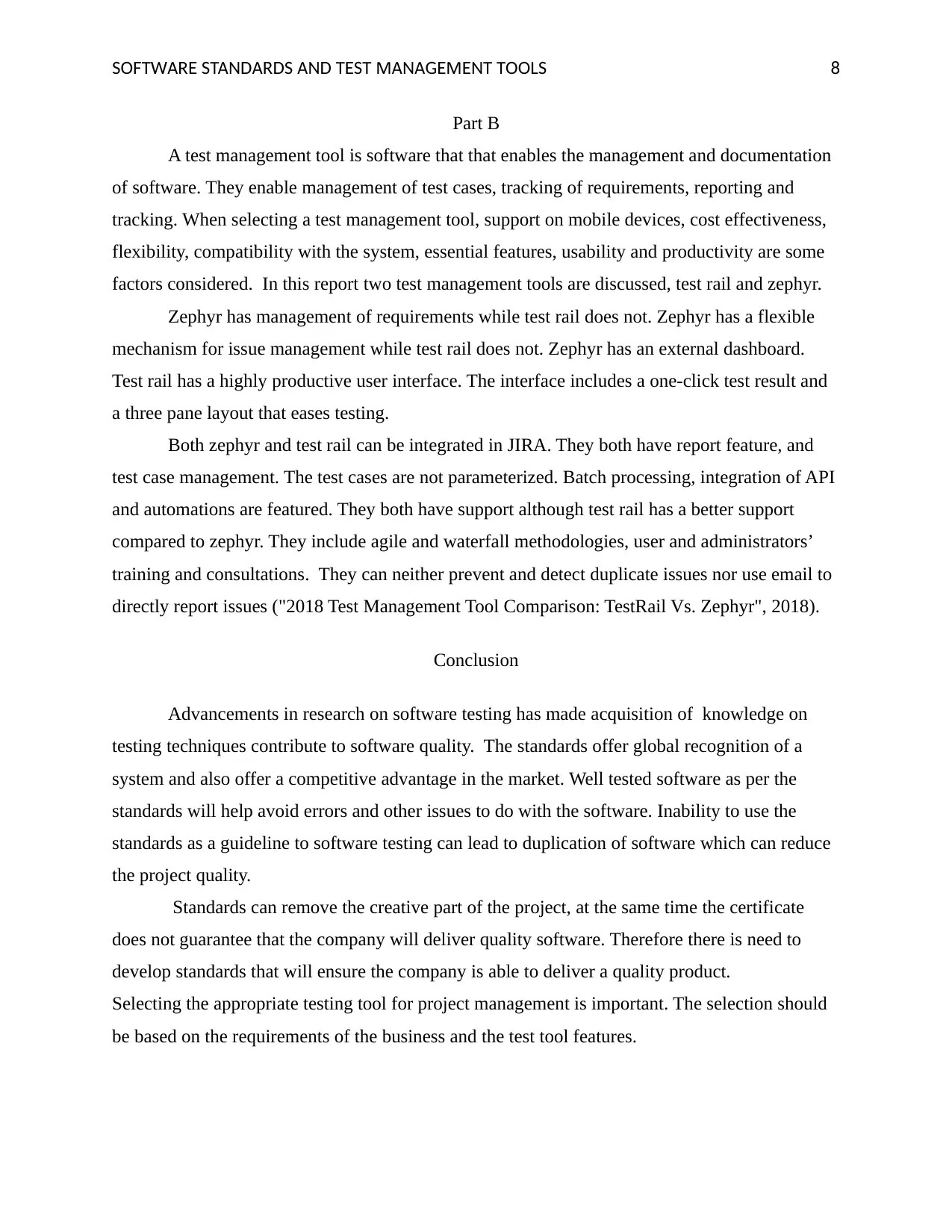
T A TA A A T T MA A M T TSOF W RE S ND RDS ND ES N GE EN OOLS 8
Part B
A test management tool is software that that enables the management and documentation
of software. They enable management of test cases, tracking of requirements, reporting and
tracking. When selecting a test management tool, support on mobile devices, cost effectiveness,
flexibility, compatibility with the system, essential features, usability and productivity are some
factors considered. In this report two test management tools are discussed, test rail and zephyr.
Zephyr has management of requirements while test rail does not. Zephyr has a flexible
mechanism for issue management while test rail does not. Zephyr has an external dashboard.
Test rail has a highly productive user interface. The interface includes a one-click test result and
a three pane layout that eases testing.
Both zephyr and test rail can be integrated in JIRA. They both have report feature, and
test case management. The test cases are not parameterized. Batch processing, integration of API
and automations are featured. They both have support although test rail has a better support
compared to zephyr. They include agile and waterfall methodologies, user and administrators’
training and consultations. They can neither prevent and detect duplicate issues nor use email to
directly report issues ("2018 Test Management Tool Comparison: TestRail Vs. Zephyr", 2018).
Conclusion
Advancements in research on software testing has made acquisition of knowledge on
testing techniques contribute to software quality. The standards offer global recognition of a
system and also offer a competitive advantage in the market. Well tested software as per the
standards will help avoid errors and other issues to do with the software. Inability to use the
standards as a guideline to software testing can lead to duplication of software which can reduce
the project quality.
Standards can remove the creative part of the project, at the same time the certificate
does not guarantee that the company will deliver quality software. Therefore there is need to
develop standards that will ensure the company is able to deliver a quality product.
Selecting the appropriate testing tool for project management is important. The selection should
be based on the requirements of the business and the test tool features.
Part B
A test management tool is software that that enables the management and documentation
of software. They enable management of test cases, tracking of requirements, reporting and
tracking. When selecting a test management tool, support on mobile devices, cost effectiveness,
flexibility, compatibility with the system, essential features, usability and productivity are some
factors considered. In this report two test management tools are discussed, test rail and zephyr.
Zephyr has management of requirements while test rail does not. Zephyr has a flexible
mechanism for issue management while test rail does not. Zephyr has an external dashboard.
Test rail has a highly productive user interface. The interface includes a one-click test result and
a three pane layout that eases testing.
Both zephyr and test rail can be integrated in JIRA. They both have report feature, and
test case management. The test cases are not parameterized. Batch processing, integration of API
and automations are featured. They both have support although test rail has a better support
compared to zephyr. They include agile and waterfall methodologies, user and administrators’
training and consultations. They can neither prevent and detect duplicate issues nor use email to
directly report issues ("2018 Test Management Tool Comparison: TestRail Vs. Zephyr", 2018).
Conclusion
Advancements in research on software testing has made acquisition of knowledge on
testing techniques contribute to software quality. The standards offer global recognition of a
system and also offer a competitive advantage in the market. Well tested software as per the
standards will help avoid errors and other issues to do with the software. Inability to use the
standards as a guideline to software testing can lead to duplication of software which can reduce
the project quality.
Standards can remove the creative part of the project, at the same time the certificate
does not guarantee that the company will deliver quality software. Therefore there is need to
develop standards that will ensure the company is able to deliver a quality product.
Selecting the appropriate testing tool for project management is important. The selection should
be based on the requirements of the business and the test tool features.
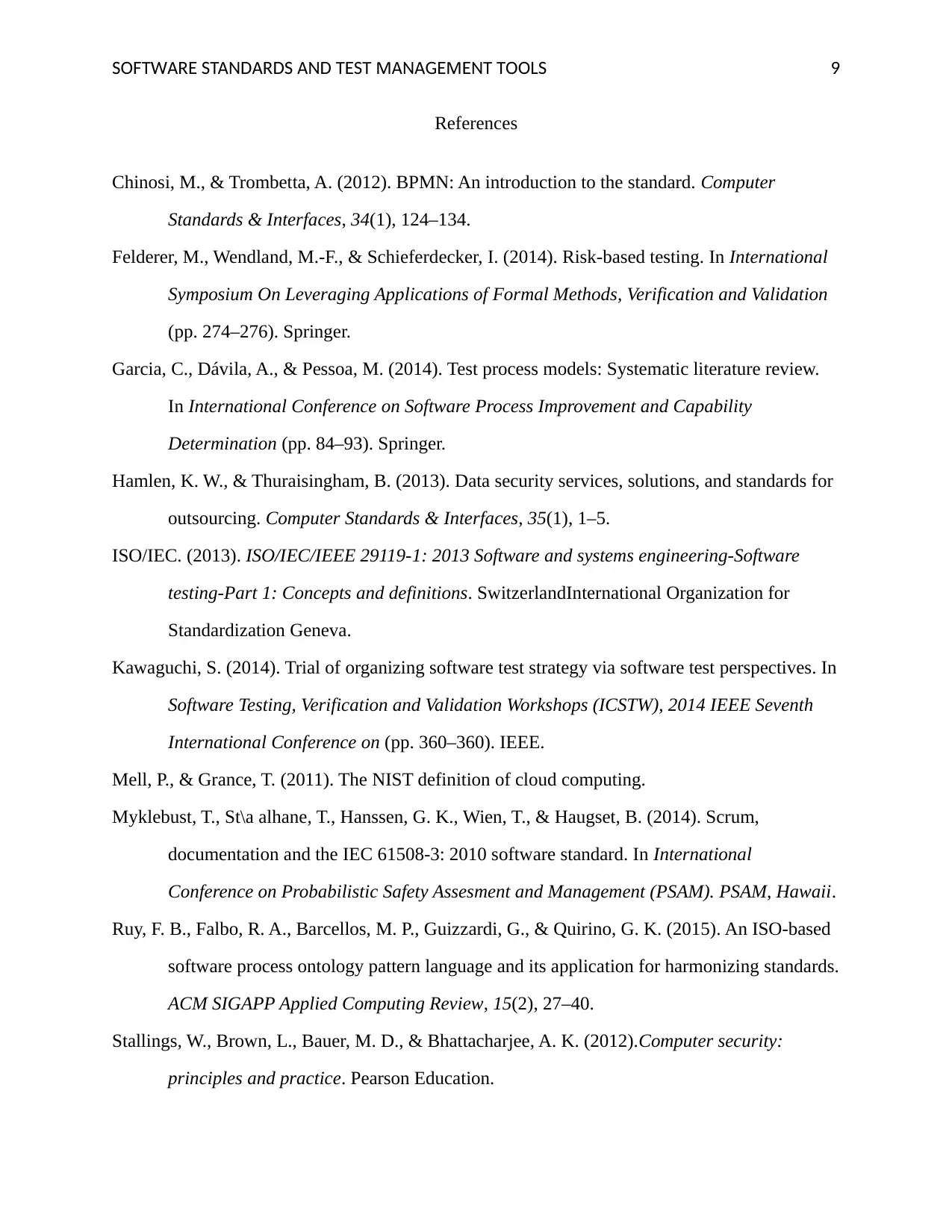
T A TA A A T T MA A M T TSOF W RE S ND RDS ND ES N GE EN OOLS 9
References
Chinosi, M., & Trombetta, A. (2012). BPMN: An introduction to the standard. Computer
Standards & Interfaces, 34(1), 124–134.
Felderer, M., Wendland, M.-F., & Schieferdecker, I. (2014). Risk-based testing. In International
Symposium On Leveraging Applications of Formal Methods, Verification and Validation
(pp. 274–276). Springer.
Garcia, C., Dávila, A., & Pessoa, M. (2014). Test process models: Systematic literature review.
In International Conference on Software Process Improvement and Capability
Determination (pp. 84–93). Springer.
Hamlen, K. W., & Thuraisingham, B. (2013). Data security services, solutions, and standards for
outsourcing. Computer Standards & Interfaces, 35(1), 1–5.
ISO/IEC. (2013). ISO/IEC/IEEE 29119-1: 2013 Software and systems engineering-Software
testing-Part 1: Concepts and definitions. SwitzerlandInternational Organization for
Standardization Geneva.
Kawaguchi, S. (2014). Trial of organizing software test strategy via software test perspectives. In
Software Testing, Verification and Validation Workshops (ICSTW), 2014 IEEE Seventh
International Conference on (pp. 360–360). IEEE.
Mell, P., & Grance, T. (2011). The NIST definition of cloud computing.
Myklebust, T., St\a alhane, T., Hanssen, G. K., Wien, T., & Haugset, B. (2014). Scrum,
documentation and the IEC 61508-3: 2010 software standard. In International
Conference on Probabilistic Safety Assesment and Management (PSAM). PSAM, Hawaii.
Ruy, F. B., Falbo, R. A., Barcellos, M. P., Guizzardi, G., & Quirino, G. K. (2015). An ISO-based
software process ontology pattern language and its application for harmonizing standards.
ACM SIGAPP Applied Computing Review, 15(2), 27–40.
Stallings, W., Brown, L., Bauer, M. D., & Bhattacharjee, A. K. (2012).Computer security:
principles and practice. Pearson Education.
References
Chinosi, M., & Trombetta, A. (2012). BPMN: An introduction to the standard. Computer
Standards & Interfaces, 34(1), 124–134.
Felderer, M., Wendland, M.-F., & Schieferdecker, I. (2014). Risk-based testing. In International
Symposium On Leveraging Applications of Formal Methods, Verification and Validation
(pp. 274–276). Springer.
Garcia, C., Dávila, A., & Pessoa, M. (2014). Test process models: Systematic literature review.
In International Conference on Software Process Improvement and Capability
Determination (pp. 84–93). Springer.
Hamlen, K. W., & Thuraisingham, B. (2013). Data security services, solutions, and standards for
outsourcing. Computer Standards & Interfaces, 35(1), 1–5.
ISO/IEC. (2013). ISO/IEC/IEEE 29119-1: 2013 Software and systems engineering-Software
testing-Part 1: Concepts and definitions. SwitzerlandInternational Organization for
Standardization Geneva.
Kawaguchi, S. (2014). Trial of organizing software test strategy via software test perspectives. In
Software Testing, Verification and Validation Workshops (ICSTW), 2014 IEEE Seventh
International Conference on (pp. 360–360). IEEE.
Mell, P., & Grance, T. (2011). The NIST definition of cloud computing.
Myklebust, T., St\a alhane, T., Hanssen, G. K., Wien, T., & Haugset, B. (2014). Scrum,
documentation and the IEC 61508-3: 2010 software standard. In International
Conference on Probabilistic Safety Assesment and Management (PSAM). PSAM, Hawaii.
Ruy, F. B., Falbo, R. A., Barcellos, M. P., Guizzardi, G., & Quirino, G. K. (2015). An ISO-based
software process ontology pattern language and its application for harmonizing standards.
ACM SIGAPP Applied Computing Review, 15(2), 27–40.
Stallings, W., Brown, L., Bauer, M. D., & Bhattacharjee, A. K. (2012).Computer security:
principles and practice. Pearson Education.
⊘ This is a preview!⊘
Do you want full access?
Subscribe today to unlock all pages.

Trusted by 1+ million students worldwide
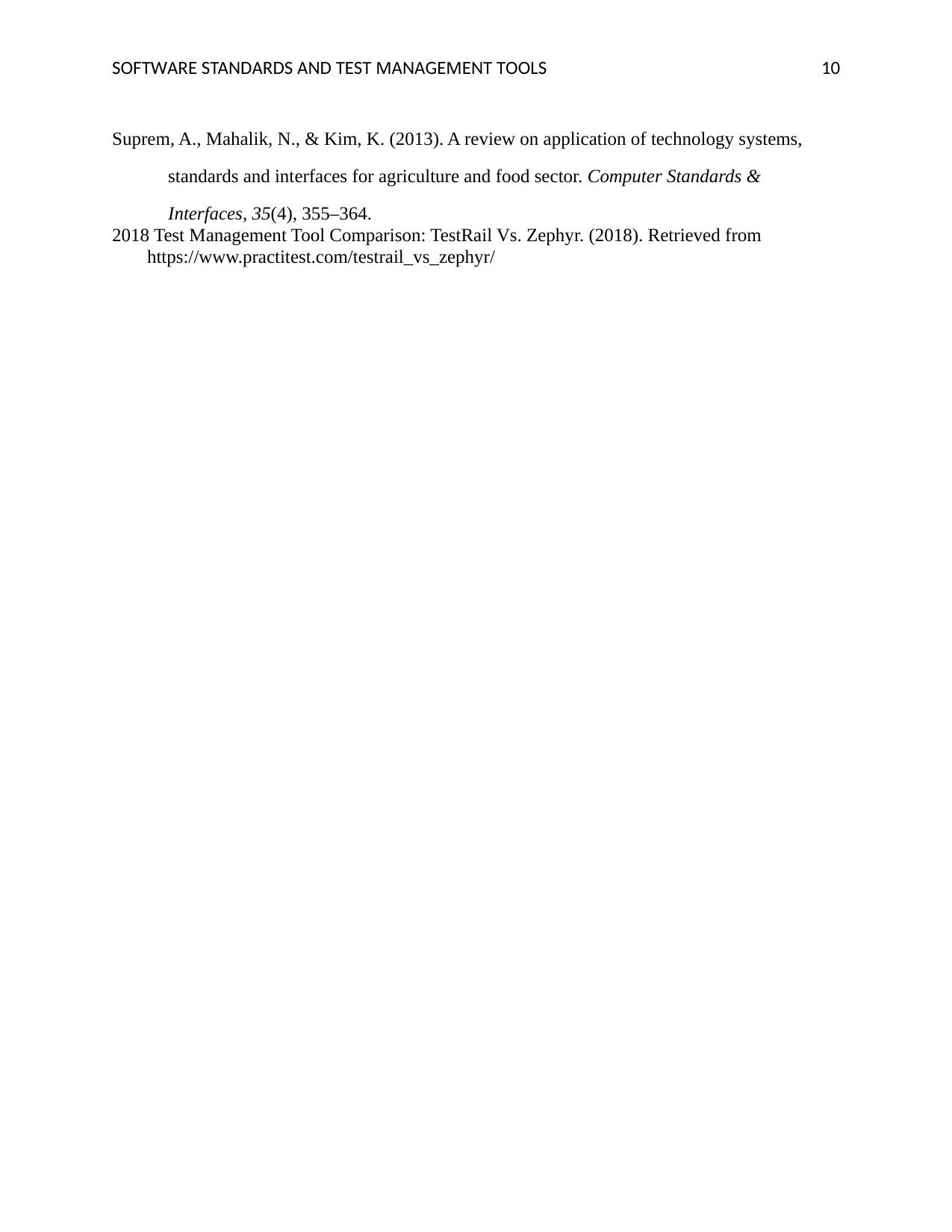
T A TA A A T T MA A M T TSOF W RE S ND RDS ND ES N GE EN OOLS 10
Suprem, A., Mahalik, N., & Kim, K. (2013). A review on application of technology systems,
standards and interfaces for agriculture and food sector. Computer Standards &
Interfaces, 35(4), 355–364.
2018 Test Management Tool Comparison: TestRail Vs. Zephyr. (2018). Retrieved from
https://www.practitest.com/testrail_vs_zephyr/
Suprem, A., Mahalik, N., & Kim, K. (2013). A review on application of technology systems,
standards and interfaces for agriculture and food sector. Computer Standards &
Interfaces, 35(4), 355–364.
2018 Test Management Tool Comparison: TestRail Vs. Zephyr. (2018). Retrieved from
https://www.practitest.com/testrail_vs_zephyr/
1 out of 10
Related Documents
Your All-in-One AI-Powered Toolkit for Academic Success.
+13062052269
info@desklib.com
Available 24*7 on WhatsApp / Email
![[object Object]](/_next/static/media/star-bottom.7253800d.svg)
Unlock your academic potential
Copyright © 2020–2025 A2Z Services. All Rights Reserved. Developed and managed by ZUCOL.





